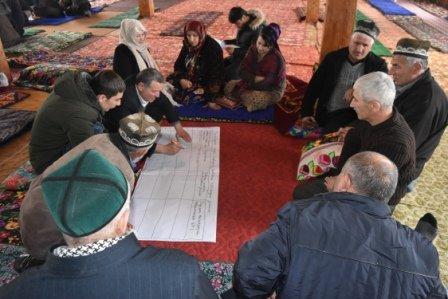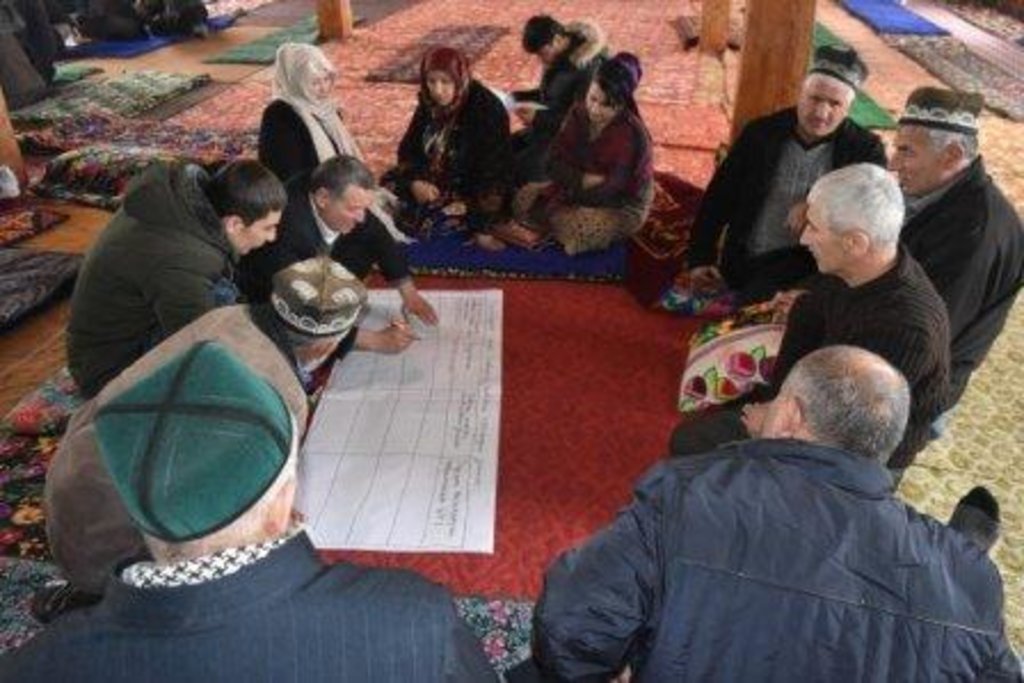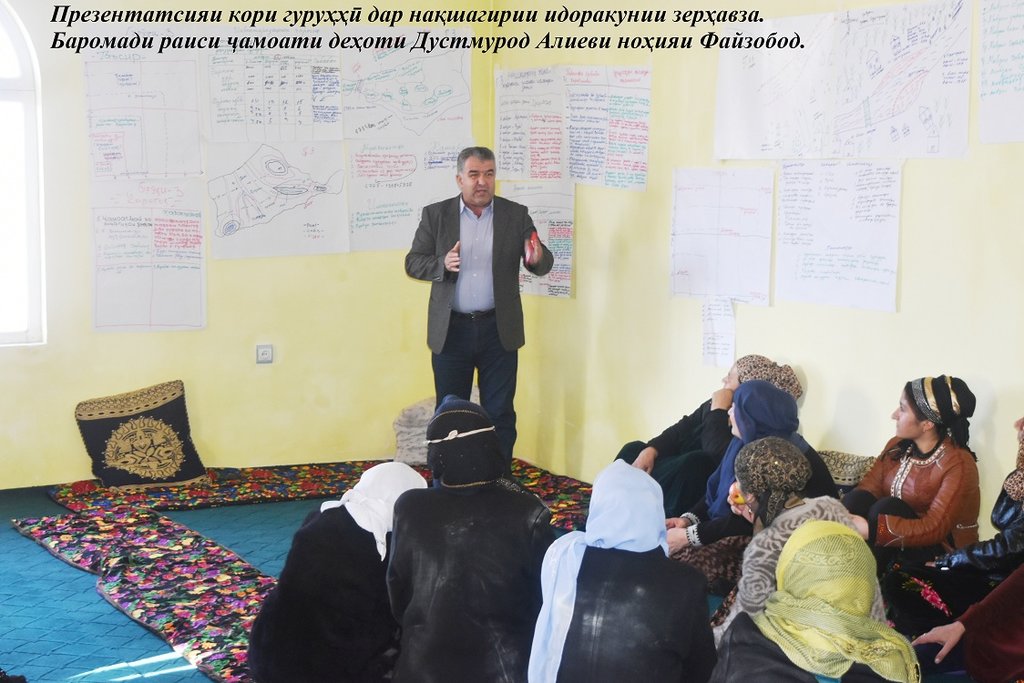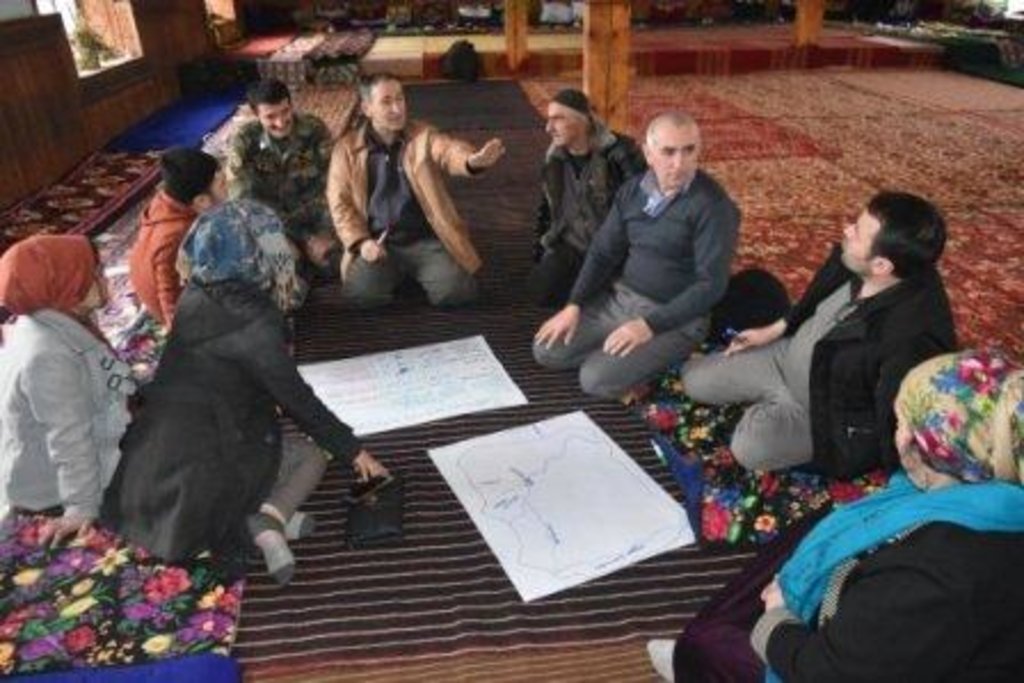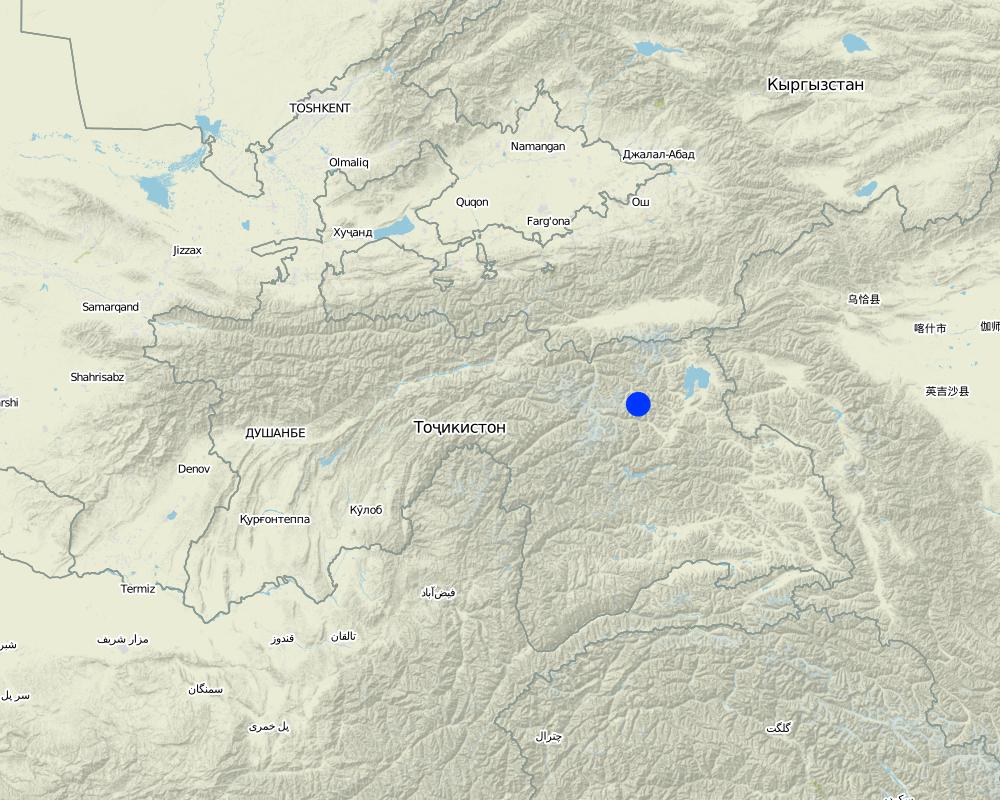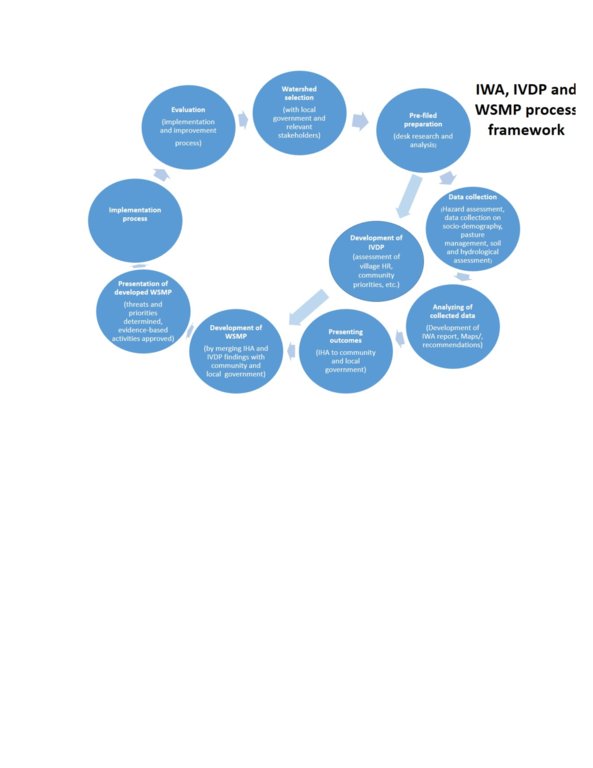Resilient Watershed Management Plan [Tadjikistan]
- Création :
- Mise à jour :
- Compilateur : Askarsho Zevarshoev
- Rédacteur : –
- Examinateur : Farrukh Nazarmavloev
Идоракуни Хавза
approaches_3612 - Tadjikistan
Voir les sections
Développer tout Réduire tout1. Informations générales
1.2 Coordonnées des personnes-ressources et des institutions impliquées dans l'évaluation et la documentation de l'Approche
Nom du projet qui a facilité la documentation/ l'évaluation de l'Approche (si pertinent)
Integrated Health and Habitat Improvement in Rasht Valley, TajikistanNom du ou des institutions qui ont facilité la documentation/ l'évaluation de l'Approche (si pertinent)
Aga Khan Foundation (AKF) - Suisse1.3 Conditions relatives à l'utilisation par WOCAT des données documentées
Quand les données ont-elles été compilées (sur le terrain)?
21/02/2018
Le compilateur et la(les) personne(s) ressource(s) acceptent les conditions relatives à l'utilisation par WOCAT des données documentées:
Oui
1.4 Références au(x) questionnaire(s) sur les Technologies de GDT
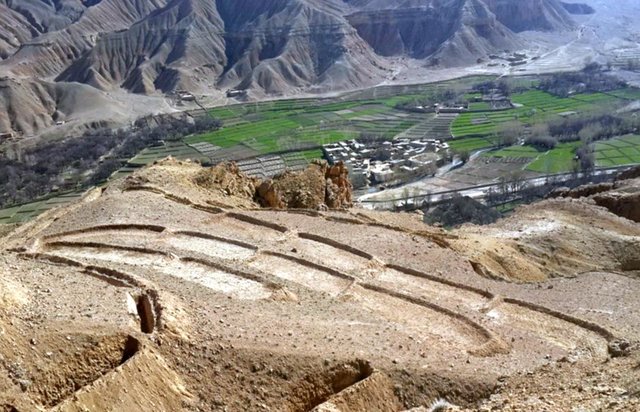
Terracing in Watershed [Afghanistan]
Reshaping unproductive land into a series of levelled, gently-sloping platforms creates conditions suitable for cultivation and prevents accelerated erosion.
- Compilateur : Aqila Haidery
2. Description de l'Approche de GDT
2.1 Courte description de l'Approche
The participatory watershed management plan (WMP) is an interdisciplinary approach at community level to raise awareness on the watershed management concept and improve understanding of the watershed approach in planning and management of natural resource.
2.2 Description détaillée de l'Approche
Description détaillée de l'Approche:
In the participatory WMPs, the main emphasis is placed on identifying critical factors (or so called thresholds) in the sub-watershed and identifying management actions to reduce the potential of negative effects of these factors on the sub-watershed ecosystems and livelihoods. In the process of participatory WMP stakeholders will identify factors that people can control and factors they cannot control. The planning is different for factors that people can control (mitigation of risk factors), for instance sustainability measures of access to safe and clean drinking water, and factors they cannot control (adaptation to risk factors), for instance melting of glaciers and formation of risk-posing glacial lakes.
In WMPs stakeholders collaborate with the technical team to incorporate key findings of the Integrated Habitat Assessment (IHA). To enhance community ownership and participation in the implementation of local development plans, communities and local authorities will be fully involved in the identification, implementation, and handover of the planning process and intervention implementations.
Based on the action plan developed as a result of participatory WMPs, interventions will be implemented to regenerate, protect, or enhance land/resource conditions in the different parts of each sub-watershed in a holistic manner in line with the IWSM approach. Projects at the village level will be identified based on the village management plan and projects operating at the sub-watershed or multi-village level will be informed by WMPs. The resilient NRM activities will be designed to specifically contribute to the improved land use and stabilization of degraded areas in the sub-watershed. During design, protection and synergies will be considered with socio-economic development project.
The WMPs will be prepared for the purpose of enhancing communities’ sustainable development through building capacities and capabilities of local communities to manage and reduce risks from natural hazards, to improve natural resources management, land use planning and pasture management. To conduct the WMP process, a working group will be established at the sub-watershed level, which will include the head of the jamoat(s), representatives from relevant district government departments (Land Management, Geology, Agriculture, Environmental Protection), and representatives from local community based organizations.
The preparation process of the WMPs will be closely coordinated and consulted with the community based organizations as well as local governments with plans conducted at the sub-watershed level. It is tentatively planned that ownership of the plans will fall to either the jamoat government (if a sub-watershed covers only one jamoat) or the district government (in the case of sub-watersheds covering more than one jamoat). However, the ownership model and other aspects of WMP process is still not clear and should be piloted in a different scenario. The WMPs will enable the target sub-watersheds to make comprehensive planning and take into account socio-economic, disaster management, and natural resources management aspects.
As a result of this process, three WMPs were developed at three sub-watershed level in Rasht Valley of Kuksu, Surkhdara and Nushor sub-watersheds. As a result the watershed committee was supported with implementation of interventions, where immediate action was required to prevent further degradation. For example in the Nushori bolo sub-watershed in consultation with government and community mobilization it was agreed to ban grazing in the most degraded upper zone of the pasture, which had also a risk of landslide. In a short period after limiting grazing the pasture areas in the upper zone of watershed started to rehabilitate.
2.3 Photos de l'approche
Remarques générales concernant les photos:
The head of the local government at the sub-district area which represents the selected watershed is presenting the agreed action plan to all stakeholders. The head of the local government is also a member of the working group on sub-watershed management together with the chairman and land use committee, environmental protection, forestry department.
2.5 Pays/ région/ lieux où l'Approche a été appliquée
Pays:
Tadjikistan
Région/ Etat/ Province:
Sub-ordinate regions
Autres spécifications du lieu :
Rasht Valley, Faizobod District
Map
×2.6 Dates de début et de fin de l'Approche
Si l'année précise est inconnue, indiquez approximativement quand l'Approche a démarré:
il y a moins de 10 ans (récemment)
2.7 Type d'Approche
- fondé sur un projet/ programme
2.8 Principaux objectifs de l'Approche
Improvement of natural resource management and prevention of natural hazards as a result of unsustainable use of natural resource.
2.9 Conditions favorisant ou entravant la mise en œuvre de la(des) Technologie(s) appliquée(s) sous l'Approche
normes et valeurs sociales/ culturelles/ religieuses
- entrave
the sub-watershed covers several communities, where each community has its own management structure with social and cultural norms. sometimes the social and cultural norms in each communities do not agree with each other because of these different norms and interests.
disponibilité/ accès aux ressources et services financiers
- favorise
the WMPs, which contains detail aspect of use on different land categories it attracts attention from different funders, including donors and government. in the framework of the project special fund was allocated fro implementation of the designed actions and interventions. This allowed land users and land specialist to implement several planned measures
cadre institutionnel
- entrave
In the framework of this approach no legal institute exists to own the WMP
collaboration/ coordination des acteurs
- favorise
entails different categories of land use, which involves collaboration among different agencies and land users
cadre juridique (régime foncier, droits d'utilisation des terres et de l'eau)
- entrave
there is not official institute, which is dedicated to watershed management. Therefore ownership of the plan is hindering further implementation after the project ends
gouvernance foncière (prise de décisions, mise en œuvre et application des décisions)
- favorise
The approach brings different local institutes, which are in charge of different natural resources together. This will enable an integrated approach to the natural resource management, as all of them are brought under one action plan.
connaissances sur la GDT, accès aux supports techniques
- favorise
The approach focuses on different SLM practices and sharing knowledge from different expertice
charge de travail, disponibilité de la main-d'œuvre
- entrave
High volume of migration of youth outside the area and high demand for labour force is hindering the process.
3. Participation et rôles des parties prenantes impliquées dans l'Approche
3.1 Parties prenantes impliquées dans l'Approche et rôles
- exploitants locaux des terres / communautés locales
community members - farmers, livestock owners, forest owners
As first level of land users they are responsible for overall management of the natural resource and its conservation.
- chercheurs
researches - pasture specialist, geobotanics, soil specialist, hydrologist
are involved in technical assessment of the resources and support communities integration of findings into their plan
- enseignants/ élèves/ étudiants
teachers on natural sciences and secondary school management
participate in the awareness raising session and support with knowledge sharing with schoolchildren, also use the new knowledge during classes.
- ONG
MSDSP Mountain Societies Development Support Programme
mobilization of stakeholders in development of their participatory plans
- gouvernement local
all departments on natural resources management - land, forest, water, pasture
controlling, supervision and mainstreaming the new approach into their working plan
3.2 Participation des exploitants locaux des terres/ communautés locales aux différentes phases de l'Approche
| Participation des exploitants locaux des terres/ communautés locales | Spécifiez qui était impliqué et décrivez les activités | |
|---|---|---|
| initiation/ motivation | soutien extérieur | supported by external consultants to provide feedback on the overall approach |
| planification | interactive | participatory approach is applied to develop the plan jointly with the land users |
| mise en œuvre | auto-mobilisation | after the plan is developed and their awareness is raised they take initiative to implement the designed interventions. |
| suivi/ évaluation | interactive | the project team jointly with the community members and working group established at the sub-watershed level conducted the monitoring. The working group, which consist of the project team and governmental officials have good knowledge on monitoring skills. |
3.3 Diagramme/ organigramme (si disponible)
Description:
The watershed management circle including the whole circle of the planning process, starting from watershed selection up to evaluation.
Auteur:
Zevarshoev Askarsho
3.4 Prises de décision pour la sélection de la Technologie/ des Technologies
Indiquez qui a décidé de la sélection de la Technologie/ des Technologies à mettre en œuvre:
- tous les acteurs concernés dans le cadre d'une approche participative
Expliquez:
The plan is developed in a participatory way, so everybody is suggesting and participating in the decision making.
Spécifiez sur quelle base ont été prises les décisions:
- l'évaluation de connaissances bien documentées en matière de GDT (prises de décision fondées sur des preuves tangibles)?
4. Soutien technique, renforcement des capacités et gestion des connaissances
4.1 Renforcement des capacités/ formation
Une formation a-t-elle été dispensée aux exploitants des terres/ autres parties prenantes?
Oui
Spécifiez qui a été formé:
- personnels/ conseillers de terrain
Si pertinent, spécifiez le genre, l'âge, le statut, l'ethnie, etc.
women and man, 50-55, local people
Formats de la formation:
- cours
Thèmes abordés:
Watershed Management
4.2 Service de conseils
Les exploitants des terres ont-ils accès à un service de conseils?
Non
4.3 Renforcement des institutions (développement organisationnel)
Des institutions ont elles été mises en place ou renforcées par le biais de l'Approche?
- oui, un peu
Spécifiez à quel(s) niveau(x), ces institutions ont été renforcées ou mises en place:
- local
Décrivez l'institution, ses rôles et responsabilités, ses membres, etc.
local level working group had been established to become owner of the watershed management plan. at the moment the working groups is unofficial and agreed to take of the plan implementation until the official structure is established
Précisez le type de soutien:
- renforcement des capacités/ formation
Donnez plus de détails:
trainings for community on watershed management, pasture and land management was conducted
4.4 Suivi et évaluation
Le suivi et l'évaluation font ils partie de l'Approche? :
Non
4.5 Recherche
La recherche a-t-elle fait partie intégrante de l’Approche?
Non
5. Financement et soutien matériel externe
5.1 Budget annuel de la composante GDT de l'Approche
Si le budget annuel précis n'est pas connu, indiquez une fourchette:
- 10 000-100 000
Commentez (par ex. principales sources de financement/ principaux bailleurs de fonds):
The implementation of the plan is depending on the size of the watershed and the condition to which extent it is degraded and requires rehabilitation measures.
5.2 Soutiens financiers/ matériels fournis aux exploitants des terres
Les exploitants des terres ont-ils reçu un soutien financier/ matériel pour la mise en œuvre de la Technologie/ des Technologies?
Non
5.3 Subventions pour des intrants spécifiques (incluant la main d'œuvre)
- aucun
Si la main d'œuvre fournie par les exploitants des terres était un intrant substantiel, elle était:
- volontaire
5.4 Crédits
Des crédits ont-ils été alloués à travers l'Approche pour les activités de GDT?
Non
5.5 Autres incitations ou instruments
D'autres incitations ou instruments ont-ils été utilisés pour promouvoir la mise en œuvre des Technologies de GDT?
Oui
Si oui, spécifiez:
Certain amount of funding was made available in the first phase to implement part of the action plan under the Watershed Management Plan
6. Analyses d'impact et conclusions
6.1 Impacts de l'Approche
Est-ce que l'Approche a autonomisé les exploitants locaux des terres, amélioré la participation des parties prenantes?
- Non
- Oui, un peu
- Oui, modérément
- Oui, beaucoup
community members were fully involved in the planning process and participated in decision making with regards to interventions. in addition community members were selected to become member of working groups, which have the opportunity to participate in the overall management of the watershed
after development the plan community were supported with implementation of several intervention specific to each watershed to see the effects
Est-ce que l'Approche a amélioré les connaissances et les capacités des exploitants des terres pour mettre en œuvre la GDT?
- Non
- Oui, un peu
- Oui, modérément
- Oui, beaucoup
the approach leads to the development of action plan with the expertise from SLM experts where different technologies are applied as a result of implementation of the actions related to watershed improvement
Est-ce que l'Approche a amélioré les connaissances et les capacités des autres parties prenantes?
- Non
- Oui, un peu
- Oui, modérément
- Oui, beaucoup
it involves also capacity building of the stakeholders and improves their awareness on the watershed management approach
Est-ce que l'Approche a amélioré l'égalité entre hommes et femmes et autonomisé les femmes et les filles?
- Non
- Oui, un peu
- Oui, modérément
- Oui, beaucoup
It brings all stakeholders together to make decision with agreement with each other. women and girls also participated actively at the community planning process and were involved in the decision making
Est-ce que l'Approche a encouragé les jeunes/ la prochaine génération d'exploitants des terres à s'engager dans la GDT?
- Non
- Oui, un peu
- Oui, modérément
- Oui, beaucoup
in the implementation process of intervention mainly were involved youth jointly with technical project team, NRM specialist and bio-soil engineering and had a chance to learn new technologies and skills
in the implementation process jointly with project experts, including NRM specialist and bio-soil engineer different SLM technologies were implemented at the sub-watershed level
Est-ce que l'Approche a amélioré la capacité des exploitants des terres à s'adapter aux changements/ extrêmes climatiques et a atténué les catastrophes liées au climat?
- Non
- Oui, un peu
- Oui, modérément
- Oui, beaucoup
beside overgrazing, heavy precipitation in the last years have exacerbate the pasture degradation. through introducing new measures this contribute to minimize the effect of the heave precipitation, which is the cause of climate change.
Est-ce que l'Approche a conduit à des emplois, des opportunités de revenus?
- Non
- Oui, un peu
- Oui, modérément
- Oui, beaucoup
it only enable stakeholders and land users with improvement of land use and disaster protection
6.2 Principale motivation des exploitants des terres pour mettre en œuvre la GDT
- réduire la dégradation des terres
In the long run the plan improves the land degradation by applying different methods and environmental protection measures.
- réduire les risques de catastrophe
In most of the cases the forms of land use which lead to disasters were banned in order to rehabilitate the area. Different technologies were applied to reduce disaster risks.
- règles et règlements (amendes)/ application
The approach focuses on improving the regulation on natural resource use in the watershed context as well as setting up common rules among different stakeholders to protect land.
6.3 Durabilité des activités de l'Approche
Les exploitants des terres peuvent-ils poursuivre ce qui a été mis en œuvre par le biais de l'Approche (sans soutien extérieur)?
- incertain
Si non ou incertain, spécifiez et commentez:
There is no legally registered entity who owns the plan as a result of the approach, otherwise the working group is consisting of governmental representatives and community members to manage the plan
6.4 Points forts/ avantages de l'Approche
| Points forts/ avantages/ possibilités du point de vue de l'exploitant des terres |
|---|
| developed in participatory manner, involved in decision making |
| Points forts/ avantages/ possibilités du point de vue du compilateur ou d'une autre personne ressource clé |
|---|
| represented by all parties involved in managing and using natural resource in the context of watershed |
| if legalized and owned by special entity can highly contribute to the improvement of natural resource conditions |
| could be replicated to other part/watershed as capacity on development of the approach is already built in the area |
6.5 Faiblesses/ inconvénients de l'Approche et moyens de les surmonter
| Faiblesses/ inconvénients/ risques du point de vue du compilateur ou d'une autre personne ressource clé | Comment peuvent-ils être surmontés? |
|---|---|
| absence of ownership interest over the plan developed as a result to the approach |
7. Références et liens
7.1 Méthodes/ sources d'information
- interviews/entretiens avec les exploitants des terres
13
- interviews/ entretiens avec les spécialistes/ experts de GDT
4
- compilation à partir de rapports et d'autres documents existants
1
7.2 Références des publications disponibles
Titre, auteur, année, ISBN:
Zevarshoev Askarsho
Disponible à partir d'où? Coût?
free, available upon request
7.3 Liens vers les informations pertinentes disponibles en ligne
Titre/ description:
Zevarshoev Askarsho/Resilient Watershed Management Methodology
URL:
available upon request
Liens et modules
Développer tout Réduire toutLiens

Terracing in Watershed [Afghanistan]
Reshaping unproductive land into a series of levelled, gently-sloping platforms creates conditions suitable for cultivation and prevents accelerated erosion.
- Compilateur : Aqila Haidery
Modules
Aucun module trouvé


